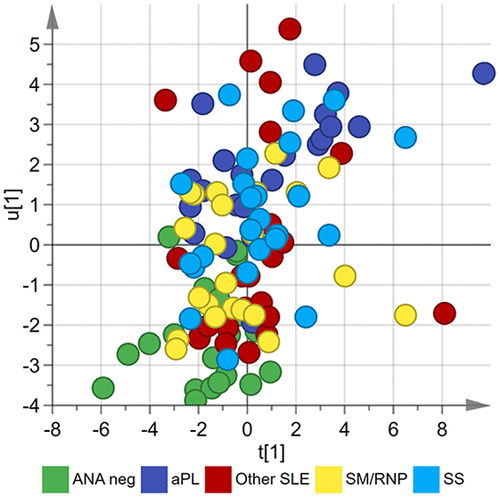当前位置:
X-MOL 学术
›
J. Proteome Res.
›
论文详情
Our official English website, www.x-mol.net, welcomes your
feedback! (Note: you will need to create a separate account there.)
Cytokine Profiles in Autoantibody Defined Subgroups of Systemic Lupus Erythematosus.
Journal of Proteome Research ( IF 3.8 ) Pub Date : 2019-02-18 , DOI: 10.1021/acs.jproteome.8b00811 Frida Torell 1 , Susanna Eketjäll 2, 3 , Helena Idborg 4 , Per-Johan Jakobsson 4 , Iva Gunnarsson 4 , Elisabet Svenungsson 4 , Johan Trygg 1, 5
Journal of Proteome Research ( IF 3.8 ) Pub Date : 2019-02-18 , DOI: 10.1021/acs.jproteome.8b00811 Frida Torell 1 , Susanna Eketjäll 2, 3 , Helena Idborg 4 , Per-Johan Jakobsson 4 , Iva Gunnarsson 4 , Elisabet Svenungsson 4 , Johan Trygg 1, 5
Affiliation

|
The aim of this study was to evaluate how the cytokine profiles differed between autoantibody based subgroups of systemic lupus erythematosus (SLE). SLE is a systemic autoimmune disease, characterized by periods of flares (active disease) and remission (inactive disease). The disease can affect many organ systems, e.g., skin, joints, kidneys, heart, and the central nervous system (CNS). SLE patients often have an overproduction of cytokines, e.g., interferons, chemokines, and interleukins. The high cytokine levels are part of the systemic inflammation, which can lead to tissue injury. In the present study, SLE patients were divided into five groups based on their autoantibody profiles. We thus defined these five groups: ANA negative, antiphospholipid (aPL) positive, anti-Sm/anti-RNP positive, Sjögren's syndrome (SS) antigen A and B positive, and patients positive for more than one type of autoantibodies (other SLE). Cytokines were measured using Mesoscale Discovery (MSD) multiplex analysis. On the basis of the cytokine data, ANA negative patients were the most deviating subgroup, with lower levels of interferon (IFN)-γ, tumor necrosis factor (TNF)-α, interleukin (IL)-12/IL-23p40, and interferon gamma-induced protein (IP)-10. Despite low cytokine levels in the ANA negative group, autoantibody profiles did not discriminate between different cytokine patterns.
中文翻译:

系统性红斑狼疮自身抗体定义的亚组中的细胞因子谱。
这项研究的目的是评估系统性红斑狼疮(SLE)的基于自身抗体的亚组之间的细胞因子谱差异。SLE是一种全身性自身免疫性疾病,其特征是爆发期(活动性疾病)和缓解期(非活动性疾病)。该疾病可影响许多器官系统,例如皮肤,关节,肾脏,心脏和中枢神经系统(CNS)。SLE患者通常会产生过量的细胞因子,例如干扰素,趋化因子和白介素。高细胞因子水平是全身性炎症的一部分,可导致组织损伤。在本研究中,SLE患者根据自身抗体谱分为五组。因此,我们将这五组定义为:ANA阴性,抗磷脂(aPL)阳性,抗Sm /抗RNP阳性,干燥综合征(SS)抗原A和B阳性,以及对一种以上自身抗体(其他SLE)呈阳性的患者。使用中尺度发现(MSD)多重分析测量细胞因子。根据细胞因子数据,ANA阴性患者是最偏离的亚组,干扰素(IFN)-γ,肿瘤坏死因子(TNF)-α,白介素(IL)-12 / IL-23p40和干扰素水平较低γ诱导蛋白(IP)-10。尽管ANA阴性组的细胞因子水平较低,但自身抗体谱无法区分不同的细胞因子模式。白介素(IL)-12 / IL-23p40和干扰素γ诱导蛋白(IP)-10。尽管ANA阴性组的细胞因子水平较低,但自身抗体谱无法区分不同的细胞因子模式。白介素(IL)-12 / IL-23p40和干扰素γ诱导蛋白(IP)-10。尽管ANA阴性组的细胞因子水平较低,但自身抗体谱无法区分不同的细胞因子模式。
更新日期:2019-02-19
中文翻译:

系统性红斑狼疮自身抗体定义的亚组中的细胞因子谱。
这项研究的目的是评估系统性红斑狼疮(SLE)的基于自身抗体的亚组之间的细胞因子谱差异。SLE是一种全身性自身免疫性疾病,其特征是爆发期(活动性疾病)和缓解期(非活动性疾病)。该疾病可影响许多器官系统,例如皮肤,关节,肾脏,心脏和中枢神经系统(CNS)。SLE患者通常会产生过量的细胞因子,例如干扰素,趋化因子和白介素。高细胞因子水平是全身性炎症的一部分,可导致组织损伤。在本研究中,SLE患者根据自身抗体谱分为五组。因此,我们将这五组定义为:ANA阴性,抗磷脂(aPL)阳性,抗Sm /抗RNP阳性,干燥综合征(SS)抗原A和B阳性,以及对一种以上自身抗体(其他SLE)呈阳性的患者。使用中尺度发现(MSD)多重分析测量细胞因子。根据细胞因子数据,ANA阴性患者是最偏离的亚组,干扰素(IFN)-γ,肿瘤坏死因子(TNF)-α,白介素(IL)-12 / IL-23p40和干扰素水平较低γ诱导蛋白(IP)-10。尽管ANA阴性组的细胞因子水平较低,但自身抗体谱无法区分不同的细胞因子模式。白介素(IL)-12 / IL-23p40和干扰素γ诱导蛋白(IP)-10。尽管ANA阴性组的细胞因子水平较低,但自身抗体谱无法区分不同的细胞因子模式。白介素(IL)-12 / IL-23p40和干扰素γ诱导蛋白(IP)-10。尽管ANA阴性组的细胞因子水平较低,但自身抗体谱无法区分不同的细胞因子模式。











































 京公网安备 11010802027423号
京公网安备 11010802027423号